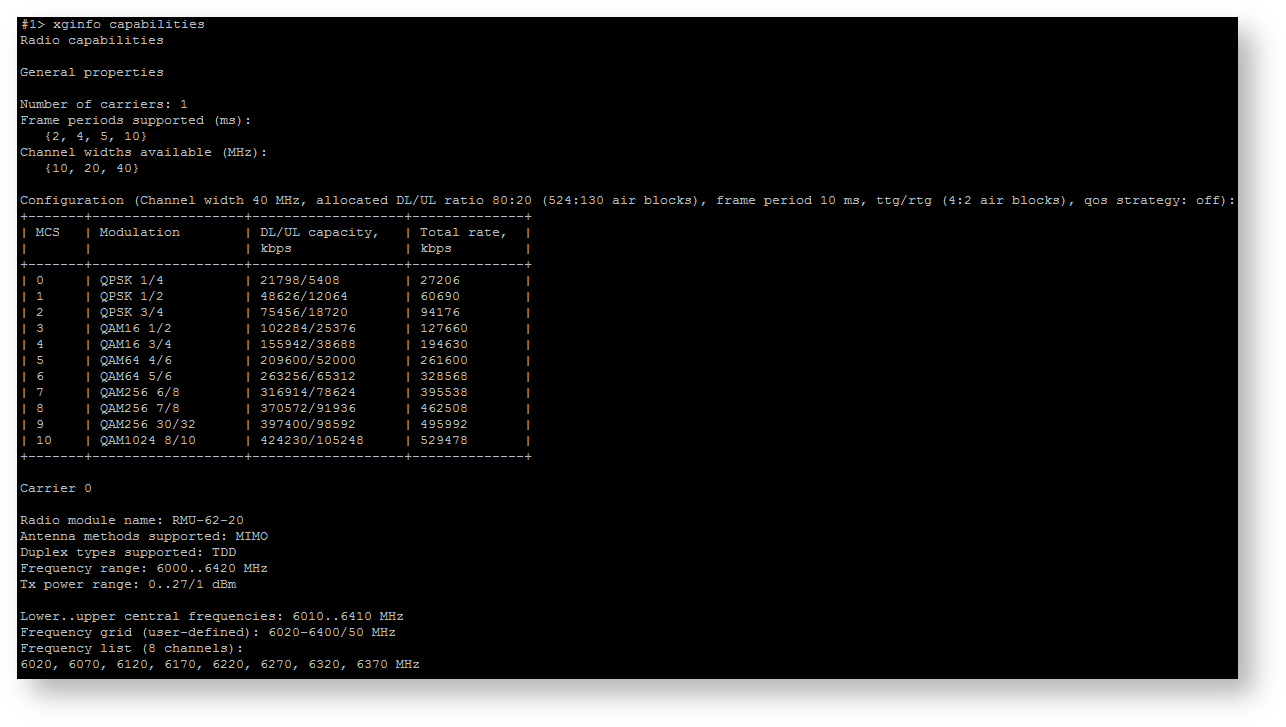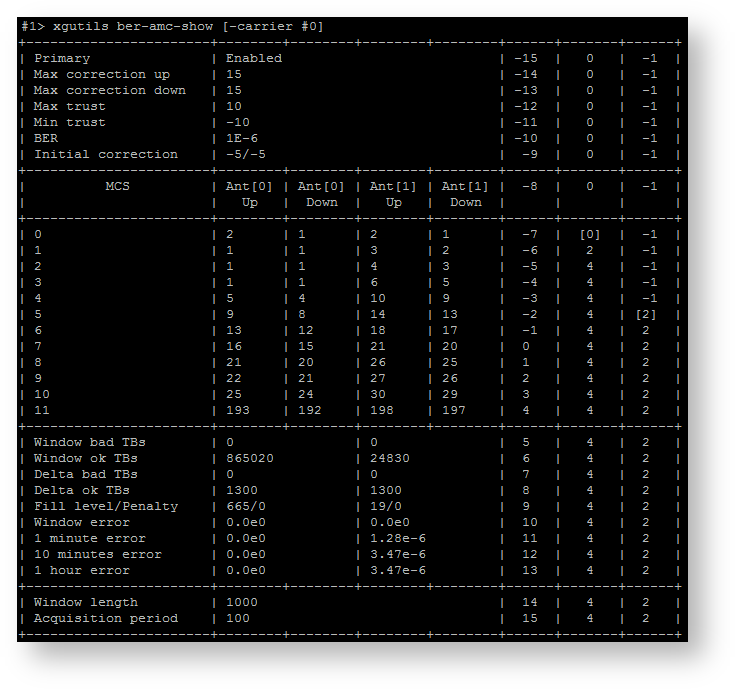"ifc radio" command
Use this command to enable or disable the system radio interface.
Syntax:
#1> ifc radio {up | down}
"xg" command
Use this command to set the air link parameters.
Syntax:
#1> xg [arguments]
#1> xg
usage:
xg config
xg config -peer-exported
xg config -defaults
xg config -make-release-defaults
xg [-grids-carrier-ix=<carrier-ix>] [-grids-band=<channel-width>] -grids {<freq_start>[-<freq_end>[/<step>]]}[,...]
xg [-grids-carrier-ix=<carrier-ix>] [-grids-band=<channel-width>] -grids=
General settings
xg -type {master, slave}
xg -tdd-sync-src {freerun, gnss}
Link shared settings (Radio Front End)
xg -cell-id {0..15/1}
xg -channel-width {10, 20, 40}
(channel-width 10): xg -freq-dl {6005..6415/50}
(channel-width 20): xg -freq-dl {6010..6410/20}
(channel-width 40): xg -freq-dl {6020..6400/50}
(channel-width 10): xg -freq-ul {6005..6415/50}
(channel-width 20): xg -freq-ul {6010..6410/20}
(channel-width 40): xg -freq-ul {6020..6400/50}
Link shared settings (Frame Config)
xg -max-distance {1..100/1}
xg -sframelen {2, 4, 5, 10}
xg -dlquota {1..99/1}
RF per-station settings
xg -txpwr {0..27/1}
xg -ctrl-block-boost {0, 1}
Modulation related
xg -amc-strategy {normal, conservative, aggressive}
xg -max-mcs {1..10/1}
DFS/RSSI scan/Radar detection
xg -freq-auto {0, 1}
Ethernet datapath related
xg -traffic-prioritization {off, on}
Supplementary
aliases:
xg -freq <val> => xg -freq-dl <val> -freq-ul <val>
"xg" command arguments description is given in the table below
| Command | Description |
|---|---|
| xg config |
|
| xg config -peer-exported |
The outputs have the following view: xg -v3-start xg -v3 <encoded web config> xg -v3-end |
| xg config -defaults |
|
| xg [-grids-carrier-ix=<carrier-ix>] [-grids-band=<channel-width>] -grids {<freq_start>[-<freq_end>[/<step>]]}[,...] |
|
| xg [-grids-carrier-ix=<carrier-ix>] [-grids-band=<channel-width>] -grids= |
|
| xg -type {master | slave} | Set the node type to "master" or "slave". Point-to-point link can be set between "master" and "slave" unit Example, xg -type master |
| xg -tdd-sync-src {freerun | gnss} |
CAUTION GNSS option is effective for "master" unit only. CAUTION Before enabling "gnss" option make sure that built-in GNSS-receiver is configured properly. Use "gps" command to configure or check the status (use values of "HDOP" up to 1.5). |
| xg -cell-id {0..15/1} |
Example, xg -cell-id 15 |
| xg -channel-width {10, 20, 40} |
|
| (channel-width 10): xg -freq-dl {6005..6415/50} (channel-width 20): xg -freq-dl {6010..6410/20} (channel-width 10): xg -freq-dl {6020..6400/50} |
Example, xg -freq-dl 6410 |
| (channel-width 10): xg -freq-ul {6005..6415/50} (channel-width 20): xg -freq-ul {6010..6410/20} (channel-width 10): xg -freq-ul {6020..6400/50} |
Example, xg -freq-ul 6400 |
| xg -freq |
Example, xg -freq 6415 |
| xg -max-distance {1..100/1} |
Example, xg -max-distance 50 |
| xg -sframelen {2, 4, 5, 10} |
Example, xg –sframelen 10 |
| xg -dlquota {1..99/1} |
xg -dlquota 80 |
| xg -txpwr {0..27/1} |
|
| xg -ctrl-block-boost {0, 1} |
|
| xg -amc-strategy {normal, conservative, aggressive} |
|
| xg -max-mcs {1..10/1} |
|
| xg -freg-auto {0, 1} |
|
| xg -traffic-prioritization {off, on} |
|
NOTE
Initial configuration procedure of the PtP link setup between InfiLINK XG units is described in the section "Commisioning of InfiLINK XG" - "InfiLINK XG - Technical User Manual"
"xginfo" command
Use this command to output the information data.
Syntax:
#1> xginfo [arguments]
#1> xginfo usage: xginfo stat [-verbose] [-clear] [-1] xginfo capabilities [-verbose] xginfo version
"xginfo" command arguments description is given in the table below
| Command | Description |
|---|---|
| xginfo stat [-verbose] [-clear] [-1] |
|
| xginfo capabilities [-verbose] |
|
| xginfo version |
|
"xgutils" command
Syntax:
#1> xgutils [arguments]
#1> xgutils usage: xgutils ber-amc-show [-carrier <CARRIER_NUM>] [-1] xgutils ber-amc-reset [-mask <STREAM_MASK>] xgutils dfs -list
"xgutils" command arguments description is given in the table below
| Command | Description |
|---|---|
| xgutils ber-amc-show [-carrier <CARRIER_NUM>] [-1] |
|
| xgutils ber-amc-reset [-mask <STREAM_MASK>] |
|
| xgutils dfs -list |
|




